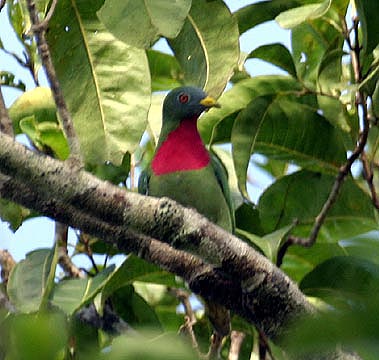- Ptilinopus viridis
Identification
- front half of head including the chin bluish-grey
- upper parts green
- wings with blue
- chest with an inverted triangle of claret, the apex extending to the lower throat
- underparts green
- undertail feathers edged pale yellow with dark green centres
- bill yellow, grey-tipped
- feet pinkish red
- eye yellow-orange with a more or less visible yellow eye ring
Female: Reference [4] suggests that the claret chest patch is reduced in size, but ebird photos suggest it's absent. The blue-grey facial pattern is reduced in area and less distinct, and the yellow eye ring is thinner.
Mature females have darker grey colour in the head markings than juveniles.
Distribution
Southeast Asia: Ambon, Buru, Seram (Moluccas), Papuan islands, Indonesia
Australasia: Papua New Guinea, Melanesia, Solomon Islands
Taxonomy
Subspecies
There are 6 subspecies [1]:
- P. v. viridis: Southern Moluccas (Buru, Seram, Ambon and adjacent islands)
- P. v. pectoralis: Western Papuan islands and north-western New Guinea
- P. v. geelvinkianus: Numfor, Biak and Meos Num islands (northern New Guinea)
- P. v. salvadorii: Yapen Island and northern New Guinea (Mamberamo River to Madang)
- P. v. vicinus: Trobriand Islands and D'Entrecasteaux Archipelago
- P. v. lewisii: Manus Island, Lihir Island, and Nissan Island to western Solomon islands
An additional subspecies pseudogeelvinkianus is generally considered invalid [2].
Habitat
Lowland moist forest.
Behaviour
They gather in large flocks to feed
References
- Clements, JF. 2010. The Clements Checklist of Birds of the World. 6th ed., with updates to December 2010. Ithaca: Cornell Univ. Press. ISBN 978-0801445019. Spreadsheet available at http://www.birds.cornell.edu/clementschecklist/Clements%206.5.xls/view
- Avibase
- Wikipedia#Eaton, JA, B van Balen, NW Brickle, FE Rheindt 2021. Birds of the Indonesian Archipelago (Greater Sundas and Wallacea), Second Edition. Lynx Editions. ISBN978-84-16728-44-2
Recommended Citation
- BirdForum Opus contributors. (2025) Claret-breasted Fruit Dove. In: BirdForum, the forum for wild birds and birding. Retrieved 9 May 2025 from https://www.birdforum.net/opus/Claret-breasted_Fruit_Dove
External Links
GSearch checked for 2020 platform.1





